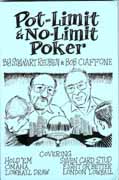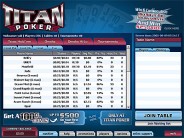Online Poker Mistakes
Playing Too Many Starting Poker HandsDrawing to Outs That Won't Help YouMiscalculating Odds with Two Cards to ComeCalling Raises Too Often on the TurnAlways Betting the RiverPlaying at Limits Too High in Relation to the BankrollOnline Poker Mistake - Not Paying AttentionOnline Poker Strategy Mistakes - Bluffing Too MuchOnline Poker Mistake - Trying to Get Back to EvenMistakes in Online Draw: Playing Come HandsOnline Poker Mistake: Playing Short-Handed with Little Experience
Pot-Limit and No-Limit Poker
by Bob Ciaffone
The first instructional work devoted exclusively to pot-limit and no-limit betting. The games covered include hold'em and Omaha; lowball draw; seven-card stud; and London lowball. Poker theory applicable to high -low split betting and tournament strategy are also thoroughly studied. Includes quizzes to grade the reader's progress, and a number of odds tables. The book is geared to readers who are already experienced poker players and who would like to learn more about the fascinating subject of big-bet poker, where the only limits on how much you can bet may be the number of chips in front of you and the size of your heart.
Titan Poker
Titan Poker has some of the best poker action on the web with plenty of tables and tournaments. Games on offer include Texas Hold'em, Omaha, Omaha Hi-Lo, and Stud. There are daily tournaments for every kind of budget. The game play interface is intuitive and includes Turbo mode and multiple tables. Titan's VIP Club rewards its players with cash back and other promotions.

Five Major Leaks in a Poker Player's Ship
by Bob Ciaffone
A poker player is a captain who pilots his own ship. He hopes to proceed without incident to his destination, but sometimes things go wrong. If the ship springs a leak, he has cause to worry. It may Bob Ciaffone is one of America’s best-known poker players, writers, and teachers. He has numerous poker tournament wins and placings, the most prominent being third place in the 1987 World Championship. He has been a poker teacher since 1995, with his students having earned well over a million dollars in tournament play. Bob's website is www.pokercoach.us be just a nuisance, or it may capsize the vessel. For sure, any captain who does not plug a leak after finding out about it is simply a fool.
Bob Ciaffone is one of America’s best-known poker players, writers, and teachers. He has numerous poker tournament wins and placings, the most prominent being third place in the 1987 World Championship. He has been a poker teacher since 1995, with his students having earned well over a million dollars in tournament play. Bob's website is www.pokercoach.us be just a nuisance, or it may capsize the vessel. For sure, any captain who does not plug a leak after finding out about it is simply a fool.
As a poker coach, I get to see a lot of leaks that need plugging. My teaching method is primarily to talk to my students about hands they have played, and try to correct their mistakes. If the same type of mistake happens repeatedly, it can be considered a leak. Extremely bad players need a new ship, but most of the people who ask me for help are already reasonably good players who want to improve their games. Here are five of their most common poker leaks:
 Bob Ciaffone is one of America’s best-known poker players, writers, and teachers. He has numerous poker tournament wins and placings, the most prominent being third place in the 1987 World Championship. He has been a poker teacher since 1995, with his students having earned well over a million dollars in tournament play. Bob's website is www.pokercoach.us be just a nuisance, or it may capsize the vessel. For sure, any captain who does not plug a leak after finding out about it is simply a fool.
Bob Ciaffone is one of America’s best-known poker players, writers, and teachers. He has numerous poker tournament wins and placings, the most prominent being third place in the 1987 World Championship. He has been a poker teacher since 1995, with his students having earned well over a million dollars in tournament play. Bob's website is www.pokercoach.us be just a nuisance, or it may capsize the vessel. For sure, any captain who does not plug a leak after finding out about it is simply a fool.1. Playing too many starting hands. This is the No. 1 offense in poker. The guys who elect to leave port in a rotted rowboat are the ones who have the most difficulty. What you start with determines what you build, and what you build determines what you wind up with. Build a 10-high flush draw and you are more likely to get into jeopardy than the guy who builds a king-high or ace-high flush draw. I am not going to explore this subject in any detail, because so much has been written about it already, but if you are going to talk about plugging leaks, the right place to start is with the biggest one. For every time that one of my students erred by not taking aggressive action when it was warranted, there were at least four times when he erred by making a call instead of folding.
2. Calling with long shots on the flop. Whether you should call with a long shot on the flop is largely a matter of pot odds. We can consider any hand with fewer outs than a straight draw a long shot, so we are largely talking about hands like two overcards (six outs), a pair that uses a boardcard (five outs), and a gutshot-straight draw (four outs). I do not recall any of my students foolishly trying to hit trips with a pocket pair (two outs).
The problem that I see over and over again with bad calls is the wrong calculation - or complete ignorance - of implied odds. "Yes, I knew that I was about a 7-to-1 dog, and the pot odds were a bit less than that, but I thought that I could make enough money after hitting to justify a call." This came from someone staying in with A-K, hoping to make a pair. Excuse me, does your pair win whenever you get there? Of course not, far from it. If you are building a weak hand, the implied odds are very much against you, because there are many times when you are drawing pretty much dead, or get outrun on the same card that helps you, or the last card. You know that a river drawout happens a lot when holding top pair on the flop, so what makes you think it is not going to happen when you make top pair on the turn? Run the chance of hitting and losing through that mental computer when calculating whether the odds are there to draw at a long shot. If the pot odds are not in your favor to play, fold unless hitting to the nuts, because the implied odds figure to be even worse than the pot odds.
3. Calling raises on the turn with only one pair. There is a lot of phony betting and raising on the flop, because the limit is only half of what it will be on the later rounds, and a draw has two shots at the cheese. When you run into strong betting on the turn, watch out. Your opponent is most likely serious. If you call a raise here, you normally are making a decision to call on the river, because it is only one more bet to see what the opponent has. The only common exception is when you call while thinking the opponent might be on a flush draw and the last card completes the flush, and you no longer can beat anything except a misread hand. So, you are normally dumping two big bets when you are wrong with a turn call. That is two hours' wages for a world-class player, and at least twice that for mere mortals. It is true that you cannot fold automatically whenever someone shoves chips in your face, but a lot of money is leaked with this type of call, so strongly consider a fold when popped on the turn.
4. Being overly aggressive against a large field. You raise a pot and get four or five callers. Unfortunately, your A-K or A-Q fails to help on the flop. This is far from surprising, since the odds are about 2-to-1 against helping such a hand. Should you bet the flop? There is a certain macho element here. You told everyone that you had a strong hand; are you now going to admit defeat by checking? So, you bet. But firing into this large a crowd on momentum alone is quite likely the wrong thing to do. Big pots with lots of players are won by the best hand - and you're not looking at it. Even worse is firing into a big crowd with a pocket pair when you have been overcoated (had an overcard come on the flop). If someone pairs the overcard, you have a two-outer. So, before you start firing chips on a crummy hand, take a count of how many people you have to eliminate to get the money. If you get to four, check your swing.
5. Being insufficiently aggressive against a small field. You would think from the earlier part of this article that I was trying to turn you into a meek mouse. Not so. When you have only one or two opponents, that's the time for aggressive poker. You are now in an environment where there is a distinct possibility that a bet or raise will win the pot, rather than the best hand. If you have a straight draw or a flush draw, it is usually right to make a play for the pot at some point, instead of just calling to try to make your hand. You can bet the flop and keep firing, or throw in a bet or raise later on. The goal is to stop someone with a weak made hand that cannot take heat from charging you a price to draw, or to get the pot when both you and the opponent are on a draw that misses. When you are able to garner a pot under one of these circumstances, instead of failing to hit and mucking your hand, it is a monster swing in your favor.
Playing a decent draw strongly is only one of many things you do in shorthanded pots to try to abscond with the money. Any piece of the board is usually worth a bet. The texture of a flop tells how vulnerable it is to a hijacking. The best flops are one big card and two little cards. Three small cards are also good, especially if you were in the blind. To tell the truth, with one of these flops, all you need to bet are two cards and some chips.
If you patch the first four leaks in your game, you will notice that the other players will try to pin a tag of "tight" on you. There is no reason for you to try to make that tag go away by giving extra action with poor-quality hands. What you should do is be aggressive in pots in which aggression has a good chance of paying off. Lots of poker players have the faulty idea that a tight player hardly ever bluffs. So, exploit the tight image that "correct" poker gives you to win more than your fair share of shorthanded pots. Once your ship gets patched, it's time to spray some wake at your competitors
[ learn to play poker! ]

